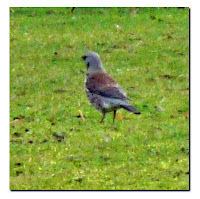We saw quite a few birds over the weekend, despite bitterly cold weather. The Blue tits continued to enjoy the coconut fat-ball in the garden, and were joined or pushed out by Robins and Great tits.
We ventured out through light snow to Anglesey Abbey, where we saw a Redwing among the snowdrops, but it was too well covered in the undergrowth for my camera to 'catch' it. We also noticed this Fieldfare, seen initially through binoculars, as it was a good distance away.
The birch wood was magical, with snowflakes falling and the occasional clump of snowdrops underground, set off by the silver shimmer of bark.
This is the mill. Folk were hard at work, packaging wholewheat flour ... and on a cold afternoon, the smell of was most compelling!
While I was looking for Fieldfare, we suddenly saw a green and yellow bird shoot past at speed. It landed on the grass, quite a long way from us, but near enough to see that it was indeed a Green Woodpecker, our first of the season.
The thrush was also a good distance away, but here's a photo for the record. It is always a joy to see the first wildflowers of a new year, and this small Violet was peeping out from the undergrowth.
I was astonished to see such an early periwinkle, but it may have been a 'garden escape'.
Then yesterday we took a chilly afternoon walk in the opposite direction, at Rendlesham Forest, near Orford. The light was very poor and once again samll flakes of snow were falling. We came across a single clump of Snowdrops. I wonder whether someone or some creature had (trans)planted them.
Rendlesham Forest in administered by the Forestry Commission, and I always like their signs. We were glad that there were coloured trails to follow as the forest is extensive.
There were small circles of ice on the water, but it was the reflected trees that caught my eye.
We drove home 'via' Orford, where I caught my first glimpse of the wildlife haven, Havergate Island, in the River Ore. We saw a Barn Owl (our second in about as many weeks) swooping low over the field and in front of our car. The light was fading and my photo didn't come out, but we enjoyed the sighting. I'm always amazed at just how pale, almost luminescent, these birds are.
2013 Bird list to date ...
1] Blue tit (HP = home patch)
2] Chaffinch (HP)
3] Wood Pigeon (HP)
4] Magpie (HP)
5] Mute Swans (Mistley and Flatford)
6] Blackbird (HP)
7] Goldfinch (HP)
8] Great tit (HP)
9] Greenfinch (HP)
10] Robin (HP)
11] Marsh harrier (Minsmere)
12] Black-headed gull (Minsmere)
13] Bullfinch (Minsmere)
14] Song Thrush (HP)
15] Wren (HP)
16] Canada Goose (Needham Market)
17] Great Crested Grebe (Needham Market)
18] Mallard (Needham Market and Flatford)
19] White ?'garden escape' Pekin duck (Needham Market)
20] Moorhen (Needham Market)
21] Jay (HP)
22] Long-tailed tit (Minsmere)
23] Cormorant (Needham Market)
24] Turnstone (Southwold, Shotley)
25] Herring Gull (Southwold and Felixstowe)
26] Shelduck (Minsmere)
27] Pheasant (Minsmere and Flatford)
28] Barn Owl (Flatford and Rendlesham)
29] Carrion Crow (HP)
30] Starling (HP)
31] Pied Wagtail (Ipswich)
32] Redwing (Anglesey Abbey)
33] Fieldfare (Anglesey Abbey)
34] Green Woodpecker (Anglesey Abbey)
35] Egyptian Goose (Ickworth)
36] Grey Heron (flying overhead)
37] Coot
38] Dunnock (HP)
Wildflowers, 2013
1] Violet
2] Aconite
3] Snowdrop (not sure how 'wild'!)
4] Periwinkle (ditto)
5] Daisy (March, HP)
6] Dog's Mercury (March, Kentwell)



































